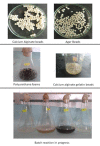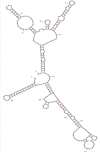Identification and characterization of cresol degrading Pseudomonas monteilii strain SHY from Soil samples
- PMID: 31223203
- PMCID: PMC6563655
- DOI: 10.6026/97320630014455
Identification and characterization of cresol degrading Pseudomonas monteilii strain SHY from Soil samples
Abstract
Cresol is an organic pollutant discharged by pharmaceutical, pesticide, coal and gasification industries causing severe organ failure in humans. Therefore, it is of interest to isolate microbes from contaminated site for degrading cresol. We isolated a strain (CR-13) that survives at 5000ppm cresol with about 80 percent cresol degradation ability. Immobilized cells showed >99 percent degradation at high concentration of cresol. The 16S rRNA sequence (accession number: MF278026) deposited in GenBank was used for phylogenetic tree analysis and the strain was grouped under Pseudomonas monteilii. The isolated cresol degrading strain was subsequently named as Pseudomonas monteilii SHY.
Keywords: 16S rRNA Gene Sequencing; Cresol degrading bacteria; Pseudomonas monteilii.
Figures













Similar articles
-
Biodegradation effects of o-cresol by Pseudomonas monteilii SHY on mustard seed germination.Bioinformation. 2018 Jun 30;14(6):271-278. doi: 10.6026/97320630014271. eCollection 2018. Bioinformation. 2018. PMID: 30237672 Free PMC article.
-
Bioaugmentation of Soil with Pseudomonas monteilii Strain Eliminates Inhibition of Okra (Abelmoschus esculentus) Seed Germination by m-Cresol.Curr Microbiol. 2021 May;78(5):1892-1902. doi: 10.1007/s00284-021-02438-4. Epub 2021 Mar 31. Curr Microbiol. 2021. PMID: 33787977
-
Characterization and application of a newly isolated pyrene-degrading bacterium, Pseudomonas monteilii.3 Biotech. 2017 Oct;7(5):309. doi: 10.1007/s13205-017-0945-9. Epub 2017 Sep 13. 3 Biotech. 2017. PMID: 28955606 Free PMC article.
-
Draft genome of formaldehyde-degrading strain, Pseudomonas monteilii IOFA19.Mar Genomics. 2014 Jun;15:1-2. doi: 10.1016/j.margen.2014.04.005. Epub 2014 May 2. Mar Genomics. 2014. PMID: 24798874
-
Isolation of bisphenol A-tolerant/degrading Pseudomonas monteilii strain N-502.Extremophiles. 2007 Mar;11(2):355-62. doi: 10.1007/s00792-006-0047-9. Epub 2006 Dec 8. Extremophiles. 2007. PMID: 17160346
Cited by
-
Characterization of natural therapeutic compounds producing novel bacterial strains isolated from Hyderabad, India.Sci Rep. 2025 Jul 16;15(1):25681. doi: 10.1038/s41598-025-11615-5. Sci Rep. 2025. PMID: 40664890 Free PMC article.
References
-
- Kumar A , Kumar S . Biochemical Engineering Journal . 2005 ; 22 : 151 .
-
- Al-Khalid T , et al. Critical Reviews in Environmental Science and Technology . 2012 ; 42 : 1631 .
-
- Wang Y , et al. J Hazard Mater. . 2017 ; 326 : 36 . - PubMed
-
- Vidali M , et al. Pure and Applied Chemistry . 2001 ; 73 : 1163 .
-
- Aneez Ahamad PY , Mohammad Kunhi AA . Biodegradation . 2011 ; 22 : 253 . - PubMed
LinkOut - more resources
Full Text Sources
